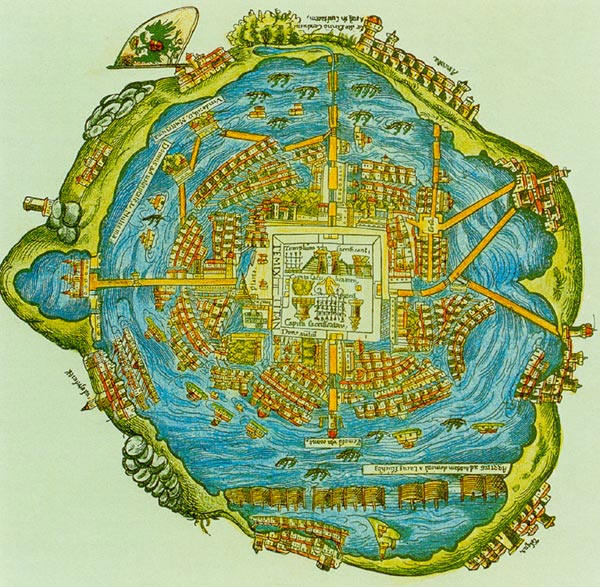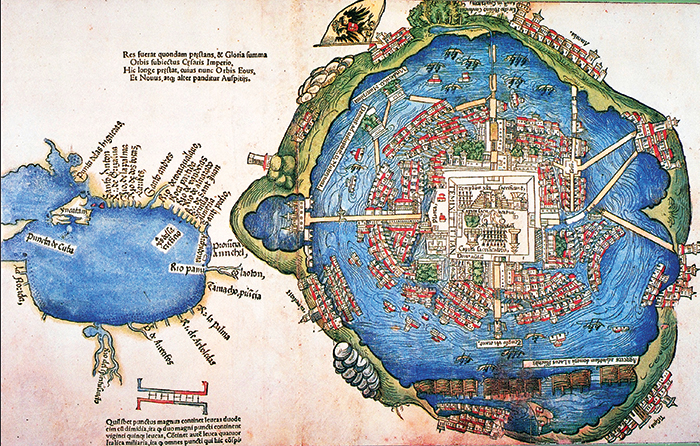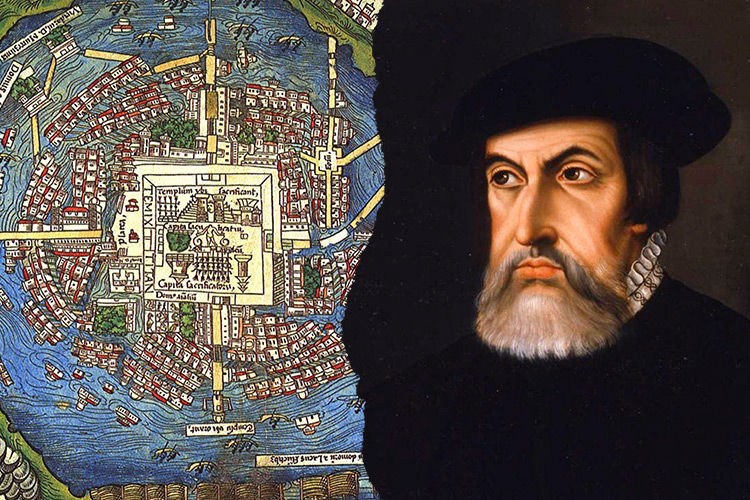The city, which was built on an island in what was then Lake Texcoco, left Hernán Cortes’ men in awe and many of them wondered if they were dreaming
An arresting view of the island of Tenochtitlan commands one wall of the Sala Azteca in the worldclass National Museum of Anthropology in Mexico City. The mural-sized panorama was painted around 1964 by artist Luis Covarrubias in conjunction with the debut of the museum’s new modernist home, a marble-clad monumental building designed by architect Pedro Ramírez Vázquez. Covarrubias’ painting presents an orthogonal vista centered on the now-lost Aztec capital city, as seen looking down from the hilly rise of Chapultepec, at the western edge of the valley (Fig. 1). Quite apart from the fact that the museum itself is located in Chapultepec, and therefore its visitors are theoretically poised to see the valley from this same viewpoint, the painting’s perspective has deeper significance. It was from this powerful vantage point that the migrating Aztecs first laid eyes on the setting for their future home. From Chapultepec, they were said to have witnessed the miraculous eagle perched on a cactus which their patron deity, Huitzilopochtli, indicated would mark the great capital of their empire.

Later, Spanish invaders, kings, and artists in a colonized Mexico assumed the same magisterial gaze for themselves. 1 Barbara Mundy, The Death of Aztec Tenochtitlan, the Life of Mexico City (Austin: University of Texas Press, 2015). The author uses the image again at the start of her In The Death of Aztec Tenochtitlan, the Life of Mexico City (2015), art historian Barbara Mundy explores the fascinating transformation of the Aztec capital city into its reincarnation as the colonial center of New Spain over the course of the sixteenth century. Even though her work provides fresh readings of a number of critical colonial materials, including both native and Spanish articulations of the urban space, the cover of the book does not feature these representations.1 Instead, the illusionistic image on the cover is Covarrubias’ commanding painting.

Although this choice is not addressed in Mundy’s book, which is logically concerned with other themes, it is an image that offers yet another perspective. Covarrubias’ painting tells a here-tofore unexplored story: that of the early twentieth century rediscovery of—and reckoning with— Mexico City’s native origins. Covarrubias’ painting marked the culmination of a half-century during which he and other thinkers articulated a new geographic consciousness that merged place and time. In the decades following a turbulent Revolution (1910-1920), Mexican artists, architects, planners, scholars, and government officials had many reasons to ponder the historic, urban foundations of the nation’s capital. In the aftermath of the civil war that engulfed the country, an educated elite of Mexico City fomented a cultural renaissance which looked to the past to redefine what it meant to be Mexican. At the same time, the nation’s geography was freshly articulated through a network of related developments, including expanding railways and roads that could move goods and people across space much more efficiently than ever before. Modern architecture provided new social and aesthetic possibilities for expanding cities; concrete and steel buildings could be built efficiently at reasonable costs and would also transform the skyline during the 1930s and 40s. To boost the economy and further development, national and international tourism in Mexico was heavily promoted, especially during the presidency of Lázaro Cárdenas (1934-40); at this time, visitors were encouraged to enjoy both traditional cultural attractions and the comfort of modern amenities in the capital city, including top notch hotels, restaurants, and shops. Such developments set the foundations for the so-called Mexican miracle when sustained growth would move an industriallytriumphant Mexico into the second half of the twentieth century.

This transformative modernization stood in particular contrast to new revelations through Mexican archaeology. The excavations of anthropologist Manuel Gamio, whose 1916 nationalist manifesto called for the cultural assimilation of indigenous Mexico to forge the modern nation, dramatically brought the native past into the living present. His investigations at the pre-Aztec city of Teotihuacan, facilitated by a 1908 feeder train line that would soon carry droves of tourists to the area, culminated in a critical study that further helped to signal the country’s foundational indigeneity.2 Perhaps still more tantalizing were the early excavations at Mexico City’s heart. As head of the ‘Inspección general de 2 The cover of Gamio’s Forjando Patria (Pro Nacionalismo) (Mexico: Porrúa Hermanos, 1916) grounded post-revolutionary identity in the Aztec past with a depiction of the legendary eagle and cactus that marked both the foundation of Tenochtitlan and its actual place name. His studies at Teotihuacan culminated in La población del valle de Teotihuacan (Mexico: Direccion de Antropología, Secretaria de Agricultura y Fomento, 1922). monumentos arqueológicos’ beginning in 1910, Gamio recognized the need to take careful note of the location and depth of hundreds of objects in the city center as demolished buildings unexpectedly revealed earlier cultural material. This ultimately led to his 1913 excavations which uncovered sculpture at the base of the Templo Mayor.
A gaping hole at the edge of the modern zocalo revealed a tantalizing glimpse of the 500-year old urban complex of Aztec Tenochtitlan buried beneath.3 This stratigraphic tension necessitated a reckoning; since extensive archaeological exploration at the city’s historic center would not begin again until the 1980s, of concern here is the way that visual and intellectual cultures of the post-Revolutionary moment engaged in a particular cartographic reckoning. This article considers the way that the urban elite of Mexico City rediscovered, reproduced, and made sense of early colonial maps from the sixteenth century. Several colonial cartographic representations of the island capital served as critical documents in the articulation of a modern Mexican identity. Through their distinctive stylistic approaches, these maps shed light on specific and conceptual aspects of the capital’s ancient foundations. They also allowed the city’s most critical boosters to demonstrate to investors, including tourists, how this emergent landscape of industrial modernity had sprung from noble, indigenous roots. Through their reproduction and circulation, and in the absence of active, large-scale archeology in the city, the colonial maps filled a void, inspiring artists and other thinkers to imagine the spectacular ancient city, its remains resting out of thei
Related Post
A shocking documentary proves that mermaids do exist
SHOCKING Revelation: Thuya, Mother of Queen Tiye, Was the Grandmother of Akhenaten and Tutankhamun—What Ancient Egyptian Secrets Did She Leave Behind?
Breaking News: Astonishing Discoveries at Karahan Tepe Confirm an Extraterrestrial Civilization is Hiding on Earth, and NO ONE Knows!
Breaking News: Researchers FINALLY Discover U.S. Navy Flight 19 After 75 Years Lost in the Bermuda Triangle!
NASA’s Secret Investigation: Uncovering the Astonishing Mystery of the UFO Crash on the Mountain!
Explosive UFO Docs LEAKED: Startling Proof That Aliens Ruled Ancient Egypt!